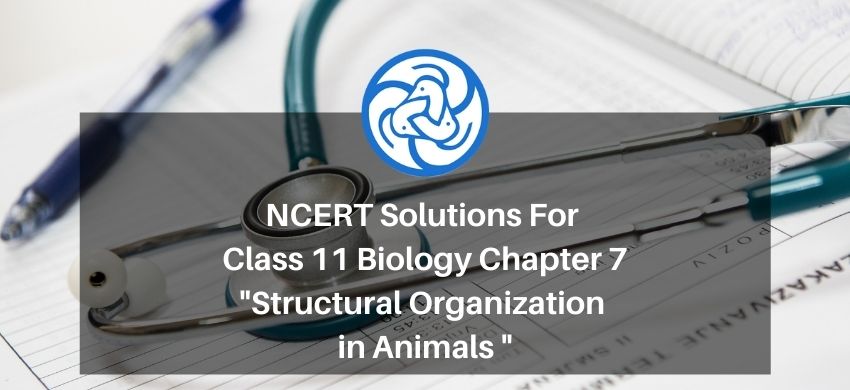
NCERT Solutions for Class 11 Biology chapter 7 Structural Organization in Animals PDF
Hey, are you a class 11 student and looking for ways to download NCERT Solutions for Class 11 Biology chapter 7 Structural Organization in Animals PDF? If yes. Then read this post till the end.In this article, we have listed NCERT Solutions for Class 11 Biology chapter 7 Structural Organization in Animals in PDF that are prepared by Kota’s top Doctor’s Faculties by keeping Simplicity in mind.
If you want to learn and understand class 11 Biology chapter 7 "Structural Organization in Animals" in an easy way then you can use these solutions PDF.
NCERT Solutions helps students to Practice important concepts of subjects easily. Class 11 Biology solutions provide detailed explanations of all the NCERT questions that students can use to clear their doubts instantly.
If you want to score high in your class 11 Biology Exam then it is very important for you to have a good knowledge of all the important topics, so to learn and practice those topics you can use eSaral NCERT Solutions.
In this article, we have listed NCERT Solutions for Class 11 Biology chapter 7 Structural Organization in Animals PDF that you can download to start your preparations anytime.
So, without wasting more time Let’s start.
Download NCERT Solutions for Class 11 Biology chapter 7 Structural Organization in Animals PDF
Question 1. Answer in one word or one line.
(i) Give the common name of Periplanata americana.
(ii) How many spermathecae are found in earthworm?
(iii) What is the position of ovaries in cockroach?
(iv) How many segments are present in the abdomen of cockroach?
(iv) How many segments are present in the abdomen of cockroach?
Solution: i) American cockroach / Cockroach
ii) Four pairs of spermathecae are found in the earthworm.
iii) Two large ovaries are found laterally lying in the $2^{\text {nd }}$ to $6^{\text {th }}$ abdominal segments.
iv) Ten segments are present in the abdomen of cockroach.
v) Malpighian tubules are present in the junction of midgut and hindgut.\
Question 2. Answer the following:
(i) What is the function of nephridia?
(ii) How many types of nephridia are found in earthworm based on their location?
Solution: i) The function of nephridia in earthworm is similar to the kidney in vertebrates. It is involved in the regulation of composition and volume of the body fluids.
ii) There are three types of nephridia, found in the earthworm based on their location. They are:
a) Septal nephridia $-$ it is found on both sides of intersegmental septa of segment 15.
b) Integumentary nephridia $-$ it is found attached to the body wall of segment 3.
c) Pharyngeal nephridia $-$ found in the form of three paired tufts in the segments $-4,5$ and 6 .
Question 3. Draw a labelled diagram of the reproductive organs of an earthworm.

Question 4. Draw a labelled diagram of alimentary canal of a cockroach.
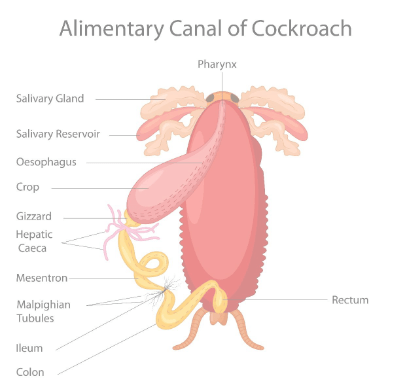
Question 5. Distinguish between the followings
(a) Prostomium and peristomium
(b) Septal nephridium and pharyngeal nephridium
Solution. a) Prostomium and peristomium


b) Septal nephridium and pharyngeal nephridium.

Question 6. What are the cellular components of blood?
Solution: Blood is mainly composed of plasma and cells. The cellular components include Red blood cells or erythrocytes, White blood cells or leucocytes and platelets.
Question 7. What are the following and where do you find them in animal body.
(a) Chondriocytes
(b) Axons
(c) Ciliated epithelium
Solution: a) Chondrocytes - They are the cells of cartilage. They are found enclosed in the small cavities within the matrix of the cartilage. They are found in the outer ear joints, between the adjacent bones of the vertebral column, nose tip, limbs and hands of adults.
b) Axons $-$ Axons are the tail-like structure found in the neuron. It is long and cylindrical and is involved in the transmission of nerve impulses from the cell body to the other neuron. The axon is covered by a myelin sheath, which helps in the transmission of impulses.
c) Ciliated epithelium - Ciliated epithelium is the columnar or cuboidal epithelium which bears cilia towards their free surface. They are involved in the passing or moving particles or mucus in a specific path of conduction. They are found in the fallopian tubes in the female reproductive system and bronchioles of lungs.
Question 8. Describe various types of epithelial tissues with the help of labelled diagrams.
Solution: Epithelial tissue or epithelium are the tissues found either facing the body fluid or the external environment. It provides covering or lining to certain parts of the body. The cells of the epithelium are closely packed with little intercellular matrix. The two main types of epithelial tissues are:
i) simple epithelium
ii) compound epithelium
1) Simple epithelium is made of a single layer of cells and found in the lining of body cavities, tubes and ducts. There are three types of simple epithelial tissues based on the structure of cell present in them. The types include:
a) Squamous epithelium
b) Cuboidal epithelium
c) Columnar epithelium
a) Squamous epithelium
It is made of a single layer of thin flattened cells and resembles the pavement tiles. Hence it is also called as pavement tissue. The cells have irregular boundaries. It is found in the walls of blood vessels, air sacs of lungs and also functions in the formation of diffusion boundary.

b) Cuboidal epithelium
It is made of a single layer of cube-shaped cells and is involved in functions such as secretion and absorption. It is found in the tubular parts of the nephron and the ducts of glands.
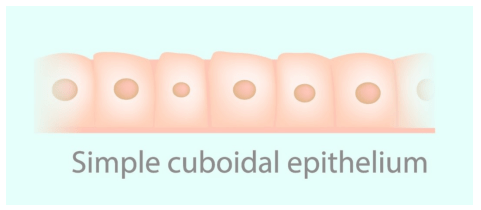
c) Columnar epithelium
It is made of a single layer of long and slender cells. The nuclei are present at the base of these cells.
They are involved in secretion and absorption processes. They may have cilia.
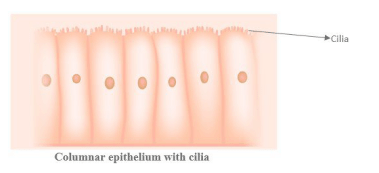
The columnar or cuboidal epithelium bearing cilia on free surface are called ciliated epithelium. They are involved in the passing or moving particles or mucus in a specific path of conduction. They are found in the fallopian tubes in the female reproductive system and bronchioles of lungs.
ii) Compound epithelium The compound epithelium has many layers of cells stacked one above the other. It is neither involved in secretion nor absorption. It functions in protecting against mechanical and chemical stresses. It is found on the skin surface, the moist surface of the mouth or buccal cavity, the inner lining of the salivary gland and pancreatic ducts, pharynx.
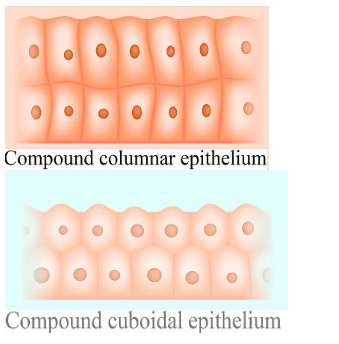
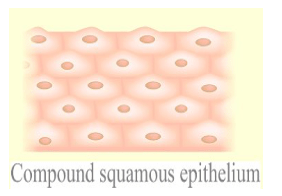
Question 9. Distinguish between
(a) Simple epithelium and compound epithelium
(b) Cardiac muscle and striated muscle [10 marks]
(c) Dense regular and dense irregular connective tissues
(d) Adipose and blood tissue
(e) Simple gland and compound gland
Solution:





Question 10. Mark the odd one in each series:
(a) Areolar tissue; blood; neuron; tendon
(b) RBC; WBC; platelets; cartilage
(c) Exocrine; endocrine; salivary gland; ligament
(d) Maxilla; mandible; labrum; antennae
(e) Protonema; mesothorax; metathorax; coxa
Solution: a) Neuron, since it is not a connective tissue.
b) Cartilage, since it is not a component of blood.
c) Ligament, since it is not a gland.
d) Antennae, since it is not one of part of the mouth of cockroach.
e)Protonema, since all others are parts of cockroach.
Question 11. Match the terms in column I with those in column II:


Solution.

Question 12. Mention breifly about the circulatory system of earthworm.
Solution. The vascular system of Earthworm is of closed type. Hence blood is confined to heart and blood vessels. It consists of blood vessels, capillaries and heart. The circulation is uni directional due to the contractions. The blood is conducted to the gut, body wall and nerve cord by the smaller blood vessels. The Blood glands present in $4^{\text {th }}, 5^{\text {th }}$ and $6^{\text {th }}$ segments are involved in the production of blood cells and haemoglobin. The haemoglobin is dissolved in blood plasma. There is an absence of specialized breathing components hence, the moist body surface of the earthworm is involved in the respiratory exchange, which is given into the bloodstream.
Question 13. Draw a neat diagram of digestive system of frog.
Solution.

Question 14. Mention the function of the following
(a) Ureters in frog
(b) Malpighian tubules
(c) Body wall in earthworm
Solution. a) Ureters in frog: It is a component of the excretory system in a frog. In male frogs, the urine and spermatozoa are both sent out through cloaca. Hence it acts as a urinogenital duct. In female frogs, the oviduct and ureters open out separately into the cloaca.
b) Malpighian tubules: It is found in the junction of midgut and hindgut and is involved in the excretory function. Each of the tubules is lined with ciliated and glandular cells. These tubules absorb nitrogenous wastes which are converted to uric acid and is excreted through the hindgut.
c) Body wall in Earthworm: The function of the body wall is to protect the delicate internal organs against injury. It also helps in burrowing and locomotion.
Also Read,
Class 11 Chemistry Notes Download.
Class 11 Biology Book Chapterwise Download.
Class 11 Biology Exemplar Chapterwise Download.
If you have any Confusion related to NCERT Solutions for Class 11 Biology chapter 7 Structural Organization in Animals PDF then feel free to ask in the comments section down below.
To watch Free Learning Videos on Class 11 Biology by Kota’s top Doctor’s Faculties Install the eSaral App
